Outline of the facilities at Bagan Medical Clinic
The Abbott at Bagan Monastery and Dr. Hla Tun have been the driving force behind this remarkable medical centre which provides virtually free medical care. Since August 2011, when the clinic first opened, it has seen rapid growth in facilities due to its popularity, thanks to the support of local and international donors including Belmond.
The first Clinic Building (opened in 2011 - see post here) remains in use as Patient Reception, Dispensary and Consulting Rooms. This has been supplemented by a larger building used for consultations, E.C.G., Laboratory and physiotherapy. That building had been open on my last visit, but it has since acquired an impressive array of second-hand gym equipment and specialist machines for heat treatment and remedial therapy and been divided to provide a consulting room, E.C.G. and Laboratory. A third building, slightly larger than the original building, was under construction on my last visit and is now fully commissioned. A central entrance area is flanked by a general consulting room one side and the consulting room used by Dr. Hla Tun on the other.
The original aim had been to provide care for the people of Bagan but the lack of affordable care in Myanmar has meant that patients are willing to travel long distances to receive treatment. Patients arrive from all parts of Myanmar using bus, train, boat and road vehicles (most commonly the passenger-carrying pick-up trucks but sometimes ancient heavy goods vehicles) and motorcycles. It's not uncommon for patients to have been travelling for two days to reach the clinic and the journey may aggravate the underlying problem. Patients from the new capital Naypyidaw, Yangon, Chin State and as far away as Magwe Division are common. To keep travel costs down, a group of patients from the same area will often club-together to hire transport and they must be prepared for a round trip lasting up to five days.
This means that looking after the welfare of waiting patients becomes a significant task. A number of shelters have been provided for waiting patients together with male and female toilet blocks. The Monastery provide a free hot lunch at around 11:30 on each clinic day and sometimes a meal is offered later in the day as well. A team of people prepare the nourishing meals which are distributed in just a few minutes to hundreds of waiting patients and their families. In addition, a number of privately-operated businesses have sprung up providing snacks and general goods.
Some of the monks are closely involved in the running of the clinic and the Abbot himself is a frequent sight around the clinic.
The Clinic is open on Friday, Saturday and Sunday each week but patients start to arrive from Wednesday. There are usually three doctors on duty, including Dr. Hla Tun. They are supported by physiotherapists and laboratory technicians. There is then a staff to assist the doctors, dispense the medication and manage the patients. Much of this work is carried out by volunteers.
Events of Friday 24th April
On Friday, 24th April 2015, I flew with Dr. Hla Tun, his son and Emily (a medical student from Ohio in the U.S.A.) on the 07:20 Air Bagan flight from Yangon Domestic Terminal to Nyaung Oo.

Nyaung Oo Airport, now polluted by huge western-style hoardings.
We were collected by the Bagan Station Manager for the luxury tour company Belmond (formerly Orient Express) who provide support for the Medical Clinic which is situated in the Monastery Compound at Old Bagan. The nearby Belmond Station at Bagan serves as the landing point for the Belmond river cruises by both 'Road to Mandalay' (which I've described in numerous earlier posts) and the new ship 'Orceila' (which I've yet to try).
When we arrived at the Monastery, we were immediately greeted by the elderly Head Monk who had arranged breakfast for us in the monastery.
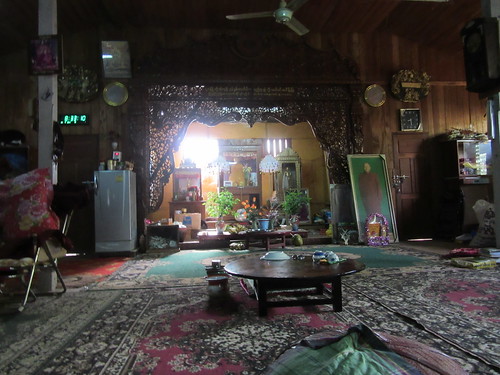 We had breakfast in the monastery.
We had breakfast in the monastery.
After our breakfast, Dr. Hla Tun took us on a conducted tour of the centre.
 Dr. Hla Tun and Emily outside the first clinic building.
Dr. Hla Tun and Emily outside the first clinic building.
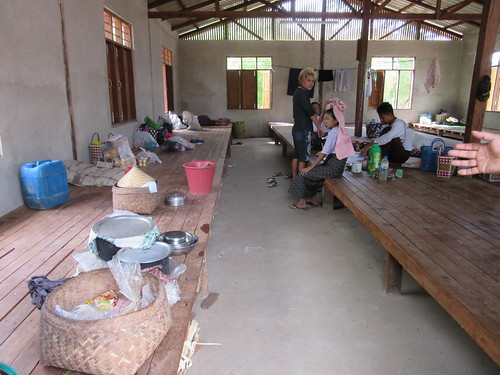 The most recent of the patient shelter buildings is of durable construction.
The most recent of the patient shelter buildings is of durable construction.
Patient numbers are unpredictable and tend to vary with the seasons. Friday was a "quiet" day. When we arrived, 180 patients had registered and a further twenty arrived later in the morning. Auxiliaries take the blood pressure of each case before they are seen by one of two doctors.
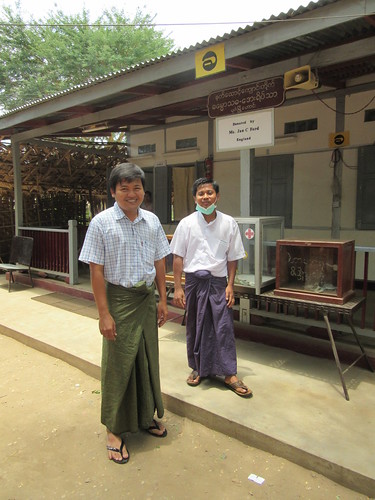
The two doctors who work with Dr. Hla Tun at the clinic.
More complex cases are referred to Dr. Hla Tun and these tend to take longer so his caseload was around 45 out of the 200 but, of course, he remains 'on call' to all the staff so there are frequent interruptions.
At 11:30, Dr. Hla Tun broke off briefly to show his visitors the offering of the free lunch. The kitchen team furiously made up the individual meals on a series of metal plates as the patients lined up to receive them.
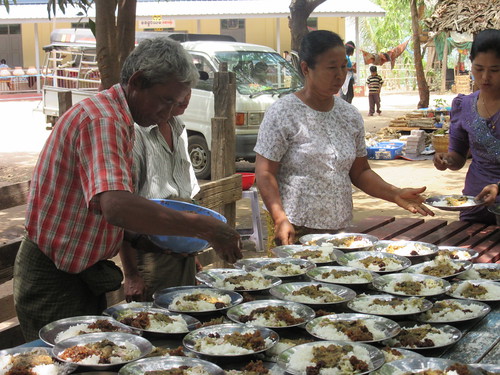 The kitchen team serving lunches.
The kitchen team serving lunches.
At first, the Head Monk offered meals to each member of the queue, next Emily was invited to make the offerings and then the writer took over. Dr. Hla Tun, together with a newly-qualified lady doctor from Myanmar who trained in the U.S.A., Emily and the writer were then invited to the Monastery for our lunch where the Head Monk kept a watchful eye to ensure we all ate enough.
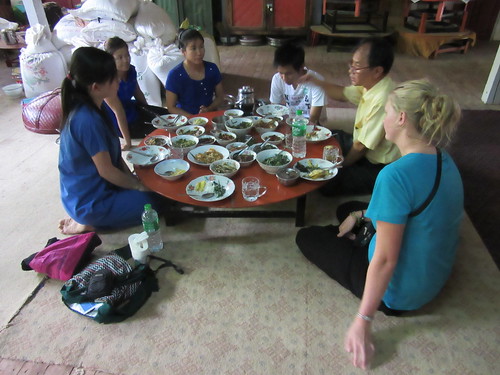 Lunch in the monastery.
Lunch in the monastery.
After taking lunch, consultations then continued in the afternoon.
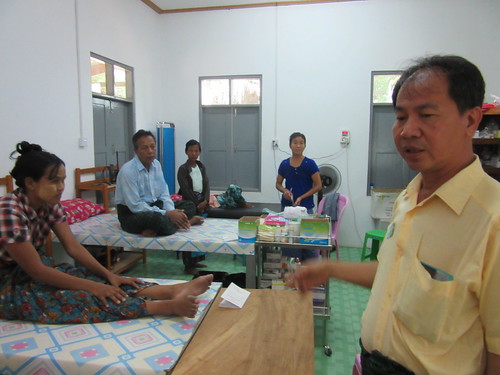 Dr. Hla Tun's consulting room has three examination couches.
Dr. Hla Tun's consulting room has three examination couches.
Emily and I left the Clinic and were taken to our respective hotels at about 17:30. This time, I was booked into the Bagan Thiripyitsaya Sanctuary Resort.
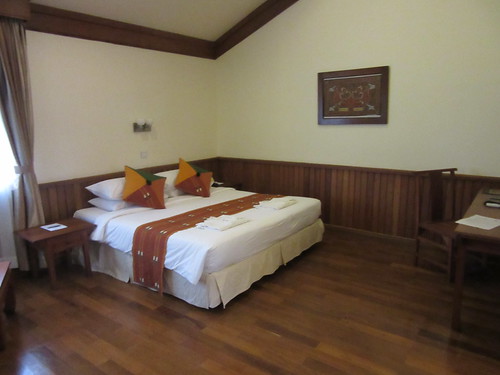 My comfortable accommodation at the Bagan Thiripyitsaya Sanctuary Resort.
My comfortable accommodation at the Bagan Thiripyitsaya Sanctuary Resort.
After a shower, I took a light meal at the hotel's open-air restaurant, offering views across the Ayeyarwaddy River. As it grew dusk, a young lady played traditional music on a Burmese Harp called a Saung.
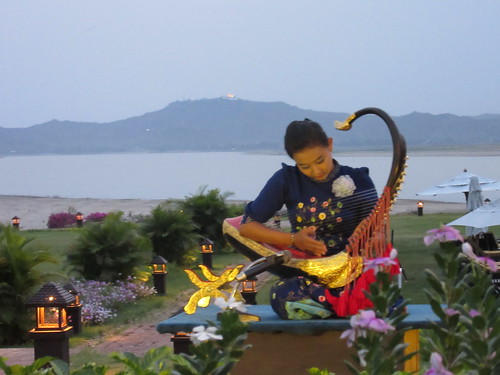 View from my hotel's open-air restaurant.
View from my hotel's open-air restaurant.
I'm afraid Dr. Hla Tun did not expect to finish his consultations until around midnight. He admitted the following morning that, in fact, he didn't finish until a quarter to one in the morning. Stamina is needed to work at the Bagan Medical Clinic!
Go to next post on this trip.
All my posts on the Bagan Medical Clinic can be found here.
All my posts describing this trip to Myanmar can be found here.
My pictures
The following albums (on Flickr) hold pictures relevant to this post:-
Bagan Clinic, Friday 24th April 2015
Bagan Thiripyitsaya Sanctuary Resort.
All my albums for this trip (except purely 'technical' ones) can be found here.
[Text revised, pictures added 10th June 2015. Text revision 20-June-2015]
